Assessment of Aromatic Hydrocarbons in Urban Air: A Study from a Northern Mexican Megacity
Abstract
1. Introduction
2. Materials and Methods
2.1. Study Area
2.2. Sampling Method
2.3. Sampling Quality Control/Quality Assurance (QA/QC)
2.4. Analysis Method
2.5. Estimation of Aromatic Hydrocarbon Ratios
2.6. Meteorological Analysis and Measurement of Criteria Air Pollutants
2.7. Statistical Analysis
2.8. Health Risk Assessment Method
3. Results
3.1. Seasonal Variation in Aromatic Hydrocarbon Concentrations
3.2. Aromatic Hydrocarbon Concentration Variations by Sampling Sites
3.3. Bivariate Analysis
3.4. Comparison with Other Urban Areas
3.5. Aromatic Hydrocarbon Ratios
3.6. Backward Air Mass Trajectories
3.7. Health Risk Assessment Results
3.7.1. Non-Cancer Risk
3.7.2. Carcinogenic Risk
4. Conclusions
Author Contributions
Funding
Institutional Review Board Statement
Informed Consent Statement
Data Availability Statement
Acknowledgments
Conflicts of Interest
References
- Alford, K.L.; Kumar, N. Pulmonary Health Effects of Indoor Volatile Organic Compounds-A Meta-Analysis. Int. J. Environ. Res. Public Health 2021, 18, 1578. [Google Scholar] [CrossRef] [PubMed] [PubMed Central]
- Hawari, N.S.L.L.; Latif, M.T.; Hamid, H.H.; Leng, T.H.; Othman, M.; Mohtar, A.A.A.; Azhar, A.; Dominick, D. The concentration of BTEX in selected urban areas of Malaysia during the COVID-19 pandemic lockdown. Urban Clim. 2022, 45, 101238. [Google Scholar] [CrossRef] [PubMed]
- Atkinson, R. Gas-phase tropospheric chemistry of organic compounds: A review. Atmos. Environ. 2007, 41, 200–240. [Google Scholar] [CrossRef]
- US EPA, Environmental Protection Agency. Technical Overview of Volatile Organic Compounds (VOCs). 2022. Available online: https://www.epa.gov/indoor-air-quality-iaq/technical-overview-volatile-organic-compounds (accessed on 30 October 2024).
- IARC, International Agency for Research on Cancer. Benzene–IARC Monographs on the Evaluation of Carcinogenic Risks to Humans; World Health Organization: Geneva, Switzerland, 2018; Volume 120, Available online: https://publications.iarc.fr/Book-And-Report-Series/Iarc-Monographs-On-The-Identification-Of-Carcinogenic-Hazards-To-Humans/Benzene-2018 (accessed on 30 November 2024).
- Civan, M.Y.; Elbir, T.; Seyfioglu, R.; Kuntasal, O.O.; Bayram, A.; Dogan, G.; Yurdakul, S.; Andic, O.; Muezzinoglu, A.; Sofuoglu, S.C.; et al. Spatial and temporal variations in atmospheric VOCs, NO2, SO2, and O3 concentrations at a heavily industrialized region in Western Turkey, and assessment of the carcinogenic risk levels of benzene. Atmos. Environ. 2015, 103, 102–113. [Google Scholar] [CrossRef]
- INECC, Instituto Nacional de Ecología y Cambio Climático; National Institute of Ecology and Climatic Change. Informe Nacional de Calidad del Aire 2018; Coordinación General de Contaminación y Salud Ambiental, Dirección de Investigación de Calidad del Aire y Contaminantes: Ciudad de México, México, 2019; Available online: http://140.84.163.2:8080/xmlui/handle/publicaciones/346 (accessed on 25 November 2024).
- INEGI, Instituto Nacional de Estadística, Geografía e Informática; National Institute of Statistics, Geography and Informatics. Registered Motor Vehicles in Circulation (VMRC). Estado de Nuevo León. 2025. Available online: https://en.www.inegi.org.mx/programas/vehiculosmotor/ (accessed on 29 November 2024).
- Cocheo, V.; Boaretto, C.; Sacco, P. High uptake rate radial diffusive sampler suitable for both solvent and thermal desorption. Am. Ind. Hyg. Assoc. J. 1996, 57, 897–909. [Google Scholar] [CrossRef]
- Healy, R.M.; Bennett, J.; Wang, J.M.; Karellas, N.S.; Wong, C.; Todd, A.; Sofowote, U.; Su, Y.; Di Federico, L.; Munoz, A.; et al. Evaluation of a passive sampling method for long-term continuous monitoring of volatile organic compounds in urban environments. Environ. Sci. Technol. 2018, 52, 10580–10589. [Google Scholar] [CrossRef]
- Sekar, A.; Varghese, G.K.; Varma, M.R. Analysis of benzene air quality standards, monitoring methods and concentrations in indoor and outdoor environment. Heliyon 2019, 5, e02918. [Google Scholar] [CrossRef]
- Chaiklieng, S.; Suggaravetsiri, P.; Kaminski, N.; Autrup, H. Exposure to benzene and toluene of gasoline station workers in Khon Kaen, Thailand and adverse effects. Hum. Ecol. Risk Assess. Int. J. 2021, 27, 1823–1837. [Google Scholar] [CrossRef]
- Cruz, L.P.; Alves, L.P.; Santos, A.V.; Esteves, M.B.; Gomes, I.V.; Nunes, L.S. Assessment of BTEX concentrations in air ambient of gas stations using passive sampling and the health risks for workers. J. Environ. Prot. 2017, 8, 12–21. [Google Scholar] [CrossRef]
- CONAPO, Consejo Nacional de Población. National Council of Population. Delimitación de Zonas Metropolitanas de México 2015, México. 2015. Available online: https://www.gob.mx/cms/uploads/attachment/file/305634/Delimitacion_Zonas_Metropolitanas_2015.pdf (accessed on 25 November 2024).
- Safronievska, I.; Petrska, J.; Bogdanov, J.; Stefova, M. Assay of volatile organic compounds in urban air using passive sampling and gas chromatography coupled to mass spectrometry. Maced. J. Ecol. Environ. 2022, 24, 103–113. [Google Scholar] [CrossRef]
- Huang, C.; Tang, L.; Dai, X.; Xiao, H. Evaluation and application of a passive air sampler for atmospheric volatile organic compounds. Aerosol Air Qual. Res. 2018, 18, 3047–3055. [Google Scholar] [CrossRef]
- INSHT, Instituto Nacional de Seguridad e Higiene en el Trabajo; National Institute of Safety and Hygiene. Determinación de Hidrocarburos Aromáticos (Benceno, Tolueno, Etilbenceno, p-Xileno, 1,2,4-Trimetilbenceno) en Aire-Método de Adsorción en Carbón Activo/Cromatografía de Gases; MTA/MA-030/A92; Ministerio del Trabajo y Asuntos Sociales de España: Madrid, Spain, 1992. [Google Scholar]
- EN 14662-5:2005; Ambient Air Quality. Standard Method for Measurement Of Benzene Concentrations. Diffusive Sampling Followed By Solvent Desorption And Gas Chromatography. British Standard: London, UK, 2010.
- Fondelli, M.C.; Bavazzano, P.; Grechi, D.; Gorini, G.; Miligi, L.; Marchese, G.; Cenni, I.; Scala, D.; Chellini, E.; Constantini, A.S. Benzene exposure in a sample of population residing in a district of Florence, Italy. Sci. Total Environ. 2008, 392, 41–49. [Google Scholar] [CrossRef] [PubMed]
- Cerón, J.G.; Cerón, R.M.; Martínez, S.; Kahl, J.; Guarnaccia, C.; Lara, R.C.; Rangel, M.; Ramírez, E.; Espinosa, M.L.; Uc, M.P.; et al. Health risk assessment of the levels of BTEX in ambient air of one urban site located in Leon, Guanajuato, Mexico during two climatic seasons. Atmosphere 2020, 11, 165. [Google Scholar] [CrossRef]
- Pekey, B.; Yılmaz, H. The use of passive sampling to monitor spatial trends of volatile organic compounds (VOCs) at an industrial city of Turkey. Microchem. J. 2011, 97, 213–219. [Google Scholar] [CrossRef]
- Keymeulen, R. Benzene, toluene, ethyl benzene and xylenes in ambient air and Pinus sylvestris L. needles: A comparative study between Belgium, Hungary, and Latvia. Atmos. Environ. 2001, 35, 6327–6335. [Google Scholar] [CrossRef]
- Li, Y.; Yan, Y.; Hu, D.; Li, Z.; Hao, A.; Li, R.; Peng, L. Source apportionment of atmospheric volatile aromatic compounds (BTEX) by stable carbon isotope analysis: A case study during heating period in Taiyuan, northern China. Atmos. Environ. 2020, 225, 117369. [Google Scholar] [CrossRef]
- WRPLOT View, v.8.0.2, Lakes Environmental Software; Lakes Environmental Inc.: Waterloo, ON, Canada, 2018.
- U.S. NOAA, HYSPLIT Model. Hybrid Single-Particle Lagrangian Integrated Trajectory Model. 2021. Available online: https://www.arl.noaa.gov/hysplit (accessed on 20 November 2024).
- Shaw, R.G.; Mitchell-Olds, T. ANOVA for unbalanced data: An overview. Ecology 1993, 74, 1638–1645. [Google Scholar] [CrossRef]
- Helsel, D.R.; Hirsch, R.M. Statistical Methods in Water Resources. U.S. Geological Survey Techniques of Water-Resources Investigations; U.S. Geological Survey: Reston, VA, USA, 2002. [Google Scholar]
- Hair, J.F.; Anderson, R.E.; Tatham, R.L.; Black, W.C. Multivariate Data Analysis, 5th ed.; Prentice Hall: Upper Saddle River, NJ, USA, 1998. [Google Scholar]
- US EPA, Environmental Protection Agency. Integrated Risk Information System (IRIS). Toxicological Review of Benzene (Non-Cancer Effects) (EPA/635/R-02/001F). 2014. Available online: https://iris.epa.gov/static/pdfs/0276tr.pdf (accessed on 25 November 2024).
- Zhang, Z.; Wang, X.; Zhang, Y.; Lu, S.; Huang, Z.; Huang, X.; Wang, Y. Ambient air benzene at background sites in China’s most developed coastal regions: Exposure levels, source implications and health risks. Sci. Total Environ. 2015, 511, 792–800. [Google Scholar] [CrossRef]
- US EPA, Environmental Protection Agency. Compendium Method TO-14A. Determination of Volatile Organic Compounds (VOCs) in Ambient Air Using Specially Prepared Canisters with Subsequent Analysis by Gas Chromatography. 1999. Available online: https://www.epa.gov/sites/default/files/2019-11/documents/to-14ar.pdf (accessed on 25 November 2024).
- US EPA, Environmental Protection Agency. Passive Samplers for Investigations of Air Quality: Method Description, Implementation, and Comparison to Alternative Sampling Methods. 1999. Available online: https://nepis.epa.gov/Adobe/PDF/P100MK4Z.pdf (accessed on 25 November 2024).
- Nejad, M.T.; Ghalehteimouri, K.J.; Talkhabi, H.; Dolatshahi, Z. The relationship between atmospheric temperature inversion and urban air pollution characteristics: A case study of Tehran, Iran. Discov. Environ. 2023, 1, 1–17. [Google Scholar] [CrossRef]
- Elminir, H.K. Dependence of urban air pollutants on meteorology. Sci. Total Environ. 2005, 350, 225–237. [Google Scholar] [CrossRef]
- Yang, J.; Shi, B.; Shi, Y.; Marvin, S.; Zheng, Y.; Xia, G. Air pollution dispersal in high density urban areas: Research on the triadic relation of wind, air pollution, and urban form. Sustain. Cities Soc. 2020, 54, 101941. [Google Scholar] [CrossRef]
- INEGI, Instituto Nacional de Estadística, Geografía e Informática. National Institute of Statistics, Geography and Informatics. Cuéntame INEGI, Información por Entidad. Estado de Nuevo León. 2020. Available online: http://cuentame.inegi.org.mx/monografias/informacion/nl/default.aspx?tema=me&e=19 (accessed on 10 December 2024).
- Monod, A.; Sive, B.C.; Avino, P.; Chen, T.; Blake, D.R.; Rowland, F.S. Monoaromatic compounds in ambient air of various cities: A focus on correlations between the xylenes and ethylbenzene. Atmos. Environ. 2001, 35, 135–149. [Google Scholar] [CrossRef]
- Wang, H.; Qiao, Y.; Chen, C.; Lu, J.; Dai, H.; Qiao, L.; Lou, S.; Huang, C.; Li, L.; Jing, S.; et al. Source profiles and chemical reactivity of volatile organic compounds from solvent use in Shanghai, China. Aerosol Air Qual. Res. 2014, 14, 301–310. [Google Scholar] [CrossRef]
- INECC, Instituto Nacional de Ecología y Cambio Climático. National Institute of Ecology and Climate Change. Emissions inventory of Monterrey Metropolitan Area. 2019. Available online: http://aire.nl.gob.mx/docs/reportes/PIGECA_2023_2033.pdf (accessed on 15 November 2024).
- Galindo, J.; Climent, H.; de la Morena, J.; González-Domínguez, D.; Guilain, S.; Besançon, T. Assessment of air-management strategies to improve the transient performance of a gasoline engine under high EGR conditions during load-decrease operation. Int. J. Engine Res. 2023, 24, 506–520. [Google Scholar] [CrossRef]
- INECC, Instituto Nacional de Ecología y Cambio Climático. National Institute of Ecology and Climatic Change. Evaluación de Compuestos Orgánicos Volátiles en el Área Metropolitana de Monterrey. 2015. Available online: https://www.gob.mx/cms/uploads/attachment/file/370440/8._Informe_Final_de_COVs_Monterrey.pdf (accessed on 16 November 2022).
- Hamid, H.H.A.; Latif, M.T.; Nadzir, M.S.M.; Uning, R.; Khan, F.; Kannan, N. Ambient BTEX levels over urban, suburban, and rural areas in Malaysia. Air Qual. Atmos. Health 2019, 12, 341–351. [Google Scholar] [CrossRef]
- Hatakeyama, S.; Kobayashi, H.; Akimoto, H. Gas-phase oxidation of sulfur dioxide in the ozone-olefin reactions. J. Phys. Chem. 1984, 88, 4736–4739. [Google Scholar] [CrossRef]
- Liu, T.; Chan, A.W.H.; Abbatt, J.P.D. Multiphase Oxidation of Sulfur Dioxide in Aerosol Particles: Implications for Sulfate Formation in Polluted Environments. Environ. Sci. Technol. 2021, 55, 4227–4242. [Google Scholar] [CrossRef]
- Atkinson, R. Atmospheric chemistry of VOCs and NOx. Atmos. Environ. 2000, 34, 2063–2101. [Google Scholar] [CrossRef]
- Słomińska, M.; Konieczka, P.; Namieśnik, J. The Fate of BTEX Compounds in Ambient Air. Crit. Rev. Environ. Sci. Technol. 2014, 44, 455–472. [Google Scholar] [CrossRef]
- Jia, M.; Zhao, T.; Cheng, X.; Gong, S.; Zhang, X.; Tang, L.; Liu, D.; Wu, X.; Wang, L.; Chen, Y. Inverse relations of PM2.5 and O3 in air compound pollution between cold and hot seasons over an urban area of East China. Atmosphere 2017, 8, 59. [Google Scholar] [CrossRef]
- Ballard, L.P.; Matus, L.K. A Study of Correlations of Ozone and Sulfur Dioxide; Report EPA-R3-72-013; Research Triangle Institute: Research Triangle Park, NC, USA, 1972. [Google Scholar]
- Wilson, W.E.; Levy, A.; Wimmer, D.B. A study of sulfur dioxide in photochemical smog II. Effect of sulfur dioxide on oxidant formation in photochemical smog. J. Air Pollut. Control Ass. 1972, 22, 27–32. [Google Scholar] [CrossRef] [PubMed]
- Khoder, M.I. Ambient levels of volatile organic compounds in the atmosphere of Greater Cairo. Atmos. Environ. 2007, 41, 554–566. [Google Scholar] [CrossRef]
- Liu, A.; Hong, N.; Zhu, P.; Guan, Y. Understanding benzene series (BTEX) pollutant load characteristics in the urban environment. Sci. Total Environ. 2018, 619, 938–945. [Google Scholar] [CrossRef]
- Yu, B.; Yuan, Z.; Yu, Z.; Xue, F. BTEX in the environment: An update on sources, fate, distribution, pretreatment, analysis, and removal techniques. Chem. Eng. J. 2022, 435, 134825. [Google Scholar] [CrossRef]
- Liu, C.; Xin, Y.; Zhang, C.; Liu, J.; Liu, P.; He, X.; Mu, Y. Ambient volatile organic compounds in urban and industrial regions in Beijing: Characteristics, source apportionment, secondary transformation and health risk assessment. Sci. Total Environ. 2023, 855, 158873. [Google Scholar] [CrossRef]
- Li, G.; Deng, S.; Li, J.; Gao, J.; Lu, Z.; Yi, X.; Liu, J. Levels, ozone and secondary organic aerosol formation potentials of BTEX and their health risks during autumn and winter in the Guanzhong Plain, China. Air Qual. Atmos. Health 2022, 15, 1941–1952. [Google Scholar] [CrossRef]
- Kerminen, V.-M.; Pirjola, L.; Boy, M.; Eskola, A.; Teinilä, K.; Laakso, L.; Asmi, A.; Hienola, J.; Lauri, A.; Vainio, V.; et al. Interaction between SO2 and submicron atmospheric particles. Atmos. Res. 2000, 54, 41–57. [Google Scholar] [CrossRef]
- Yudison, A.; Driejona, D. Determination of BTEX concentration using passive samplers in a heavy traffic area of Jakarta, Indonesia. Int. J. Geomate 2020, 19, 180–187. [Google Scholar] [CrossRef]
- Kheirbek, I.; Johnson, S.; Ross, Z.; Pezeshki, G.; Ho, K.; Eisl, H.; Matte, T. Spatial variability in levels of benzene, formaldehyde, and total benzene, toluene, ethylbenzene and xylenes in New York City: A land-use regression study. Environ. Health 2012, 11, 51. [Google Scholar] [CrossRef]
- Moolla, R.; Johnson, R.S. Spatial distribution of ambient BTEX concentrations at an International Airport in South Africa. Int. J. Environ. Ecol. Eng. 2019, 13, 43–50. [Google Scholar]
- Son, B.; Breysse, P.; Yong, W. Volatile organic compounds concentrations in residential indoor and outdoor and its personal exposure in Korea. Environ. Int. 2003, 29, 79–85. [Google Scholar] [CrossRef] [PubMed]
- Alexopoulos, E.C.; Chatzis, C.; Linos, A. An analysis of factors that influence personal exposure to toluene and xylene in residents of Athens, Greece. BMC Public Health 2006, 6, 50. [Google Scholar] [CrossRef] [PubMed]
- Kerchich, Y.; Kerbachi, R. Measurement of BTEX (Benzene, Toluene, Ethylbenzene and Xylenes) levels at urban and semirural areas of Algiers City using passive air samplers. J. Air Waste Manag. Assoc. 2012, 62, 1370–1379. [Google Scholar] [CrossRef]
- Yurdakul, S.; Civan, M.; Kuntasal, O.; Dogan, G.; Pekey, H.; Tuncel, G. Temporal variations of VOC concentrations in Bursa atmosphere. Atmos. Pollut. Res. 2018, 9, 189–206. [Google Scholar] [CrossRef]
- Alghamdi, M.; Khoder, M.; Abdelmaksoud, A.; Harrison, R.; Hussein, T.; Lihavainen, H.; Al-Jeelani, H.; Goknil, M.; Shabbaj, I.; Almehmadi, F. Seasonal and diurnal variations of BTEX and their potential for ozone formation in the urban background atmosphere of the coastal city Jeddah, Saudi Arabia. Air Qual. Atmos. Health 2014, 7, 467–480. [Google Scholar] [CrossRef]
- Tiwari, V.; Hanai, Y.; Masunaga, S. Ambient levels of volatile organic compounds in the vicinity of petrochemical industrial area of Yokohama, Japan. Air Qual. Atmos. Health 2010, 3, 65–75. [Google Scholar] [CrossRef]
- Jia, C.; Batterman, S.; Godwin, C. VOCs in industrial, urban and suburban neighborhoods: Part 1: Indoor and outdoor concentrations, variation, and risk drivers. Atmos. Environ. 2008, 42, 2083–2100. [Google Scholar] [CrossRef]
- Gelencsér, A.; Siszler, K.; Hlavay, J. Toluene−benzene concentration ratio as a tool for characterizing the distance from vehicular emission sources. Environ. Sci. Technol. 1997, 31, 2869–2872. [Google Scholar] [CrossRef]
- Liu, Y.; Shao, M.; Fu, L.; Lu, S.; Zeng, L.; Tang, D. Source profiles of volatile organic compounds (VOCs) measured in China: Part I. Atmos. Environ. 2008, 42, 6247–6260. [Google Scholar] [CrossRef]
- Nelson, R.E.; Quigley, S.M. The m,p-xylenes: Ethylbenzene ratio. A technique for estimating hydrocarbon age in ambient atmospheres. Atmos. Environ. 1986, 17, 659–662. [Google Scholar] [CrossRef]
- Hsieh, L.T.; Wang, Y.F.; Yang, H.H.; Mi, H.H. Measurements and Correlations of MTBE and BETX in Traffic Tunnels. Aerosol Air Qual. Res. 2011, 11, 763–775. [Google Scholar] [CrossRef]
- US EPA, Environmental Protection Agency. Risk Assessment Guidance for Superfund Volume I: Human Health Evaluation Manual (Part F, Supplemental Guidance for Inhalation Risk Assessment) (EPA/540/-R-070/002). 2009. Available online: https://nepis.epa.gov/Exe/ZyPURL.cgi?Dockey=P1002UOM.txt (accessed on 25 November 2024).
- Nakhjirgan, P.; Fanaei, F.; Jonidi Jafari, A.; Gholami, M.; Shahsavani, A.; Kermani, M. Extensive investigation of seasonal and spatial fluctuations of BTEX in an industrial city with a health risk assessment. Sci. Rep. 2024, 14, 23662. [Google Scholar] [CrossRef] [PubMed]
- Li, D.; Zheng, J.; Yang, M.; Meng, Y.; Yu, X.; Zhou, H.; Tong, L.; Wang, K.; Li, Y.-F.; Wang, X.; et al. Atmospheric wet deposition of trace metal elements: Monitoring and modeling. Sci. Total Environ. 2023, 893, 164880. [Google Scholar] [CrossRef] [PubMed]
- Khan, A.; Kanwal, H.; Bibi, S.; Mushtaq, S.; Khan, A.; Khan, Y.H.; Mallhi, T.H. Volatile organic compounds and neurological disorders: From exposure to preventive interventions. In Environmental Contaminants and Neurological Disorders; Springer International Publishing: Cham, Switzerland, 2021; pp. 201–230. [Google Scholar]
- Deghani, M.H.; Baghani, A.N.; Fazizadeh, M.; Ghaffari, H.R. Exposure and risk assessment of BTEX in indoor air of gyms in Tehran, Iran. Microchem. J. 2019, 150, 104135. [Google Scholar] [CrossRef]
- Kumar, A.; Singh, D.; Kumar, K.; Singh, B.B.; Jain, V.K. Distribution of VOCs in urban and rural atmospheres of subtropical India: Temporal variation, source attribution, ratios, OFP and risk assessment. Sci. Total Environ. 2018, 613–614, 492–501. [Google Scholar] [CrossRef]
- Latif, M.T.; Abd Hamid, H.H.; Ahamad, F.; Khan, M.F.; Mohd Nadzir, M.S.; Othman, M.; Sahani, M.; Abdul Wahab, M.I.; Mohamad, N.; Uning, R.; et al. BTEX compositions and its potential health impacts in Malaysia. Chemosphere 2019, 237, 124451. [Google Scholar] [CrossRef]
- Bozkurt, Z.; Üzmez, Ö.Ö.; Döğeroğlu, T.; Artun, G.; Gaga, E.O. Atmospheric concentrations of SO2, NO2, ozone and VOCs in Düzce, Turkey using passive air samplers: Sources, spatial and seasonal variations and health risk estimation. Atmos. Pollut. Res. 2018, 9, 1146–1156. [Google Scholar] [CrossRef]
- Nabizadeh, R.; Sorooshian, A.; Delikhoon, M.; Baghani, A.N.; Golbaz, S.; Aghael, M. Dataset on specifications, carcinogenic and non-carcinogenic risk of volatile organic compounds during recycling paper and cardboard. Data Brief 2020, 29, 105296. [Google Scholar] [CrossRef]
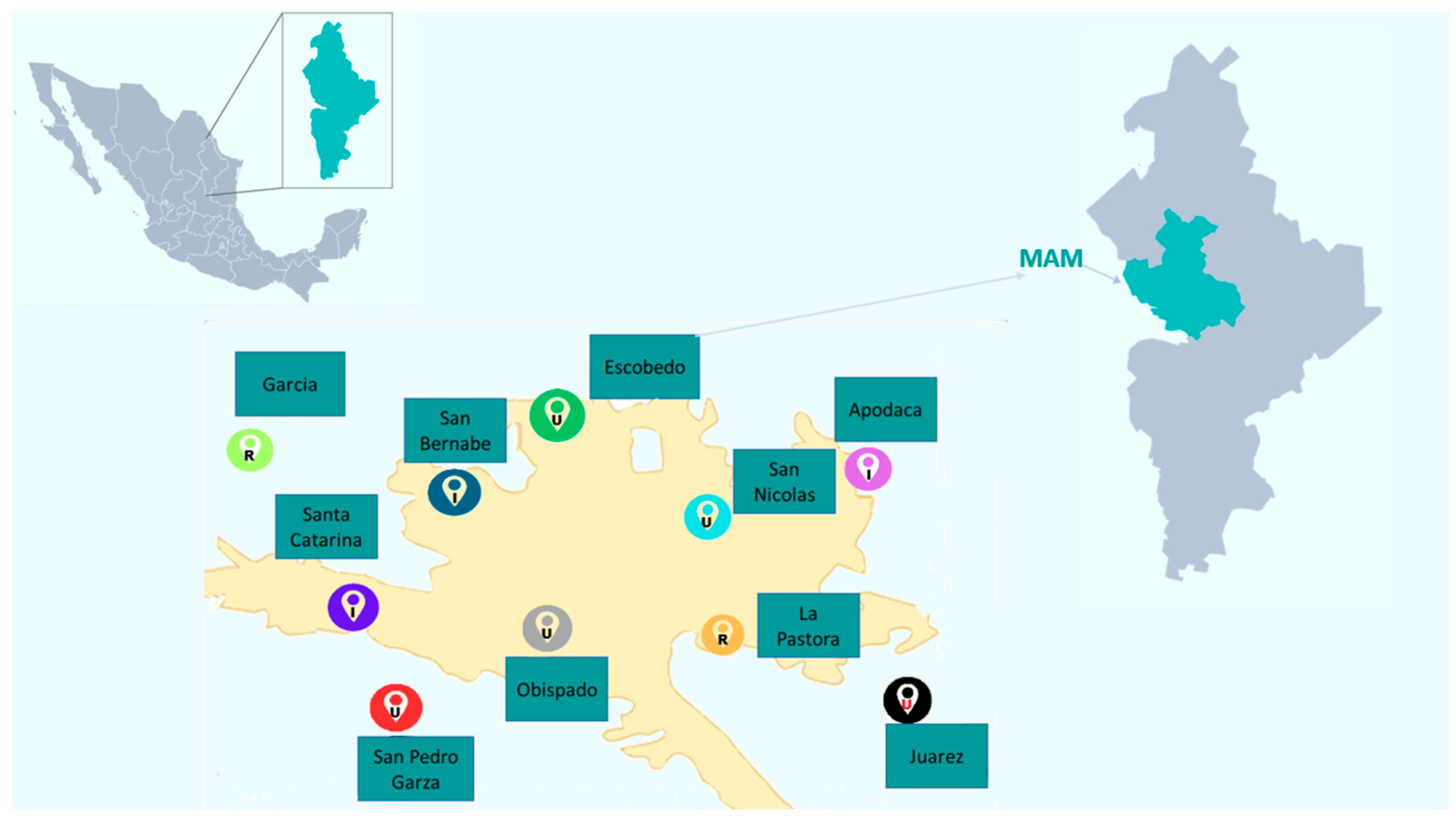
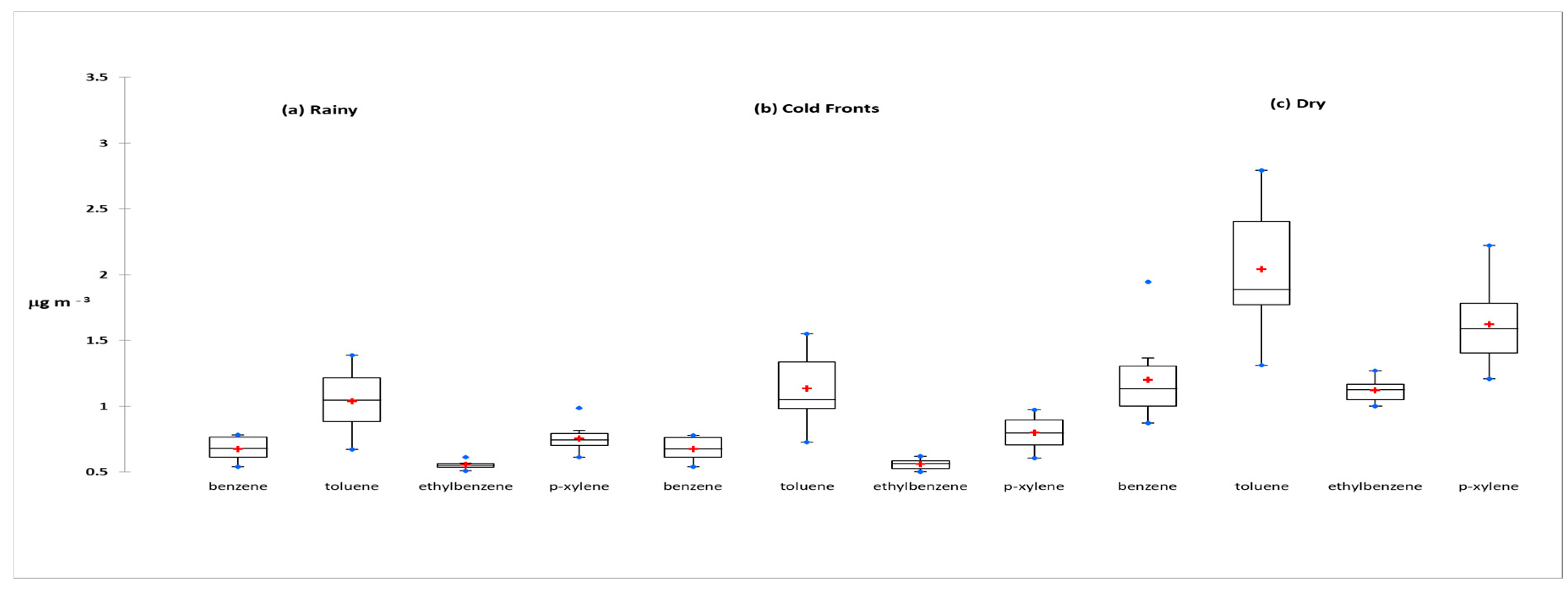
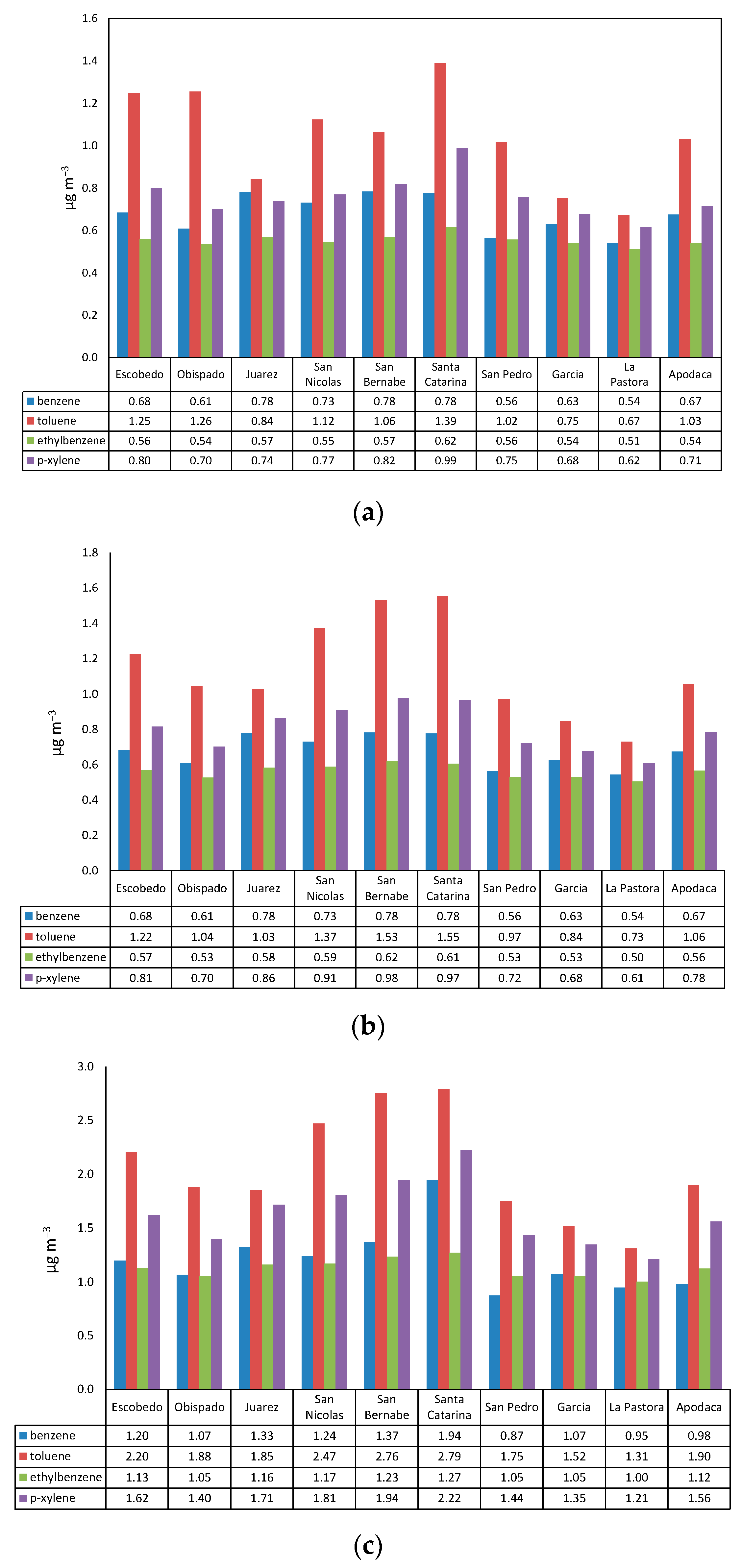
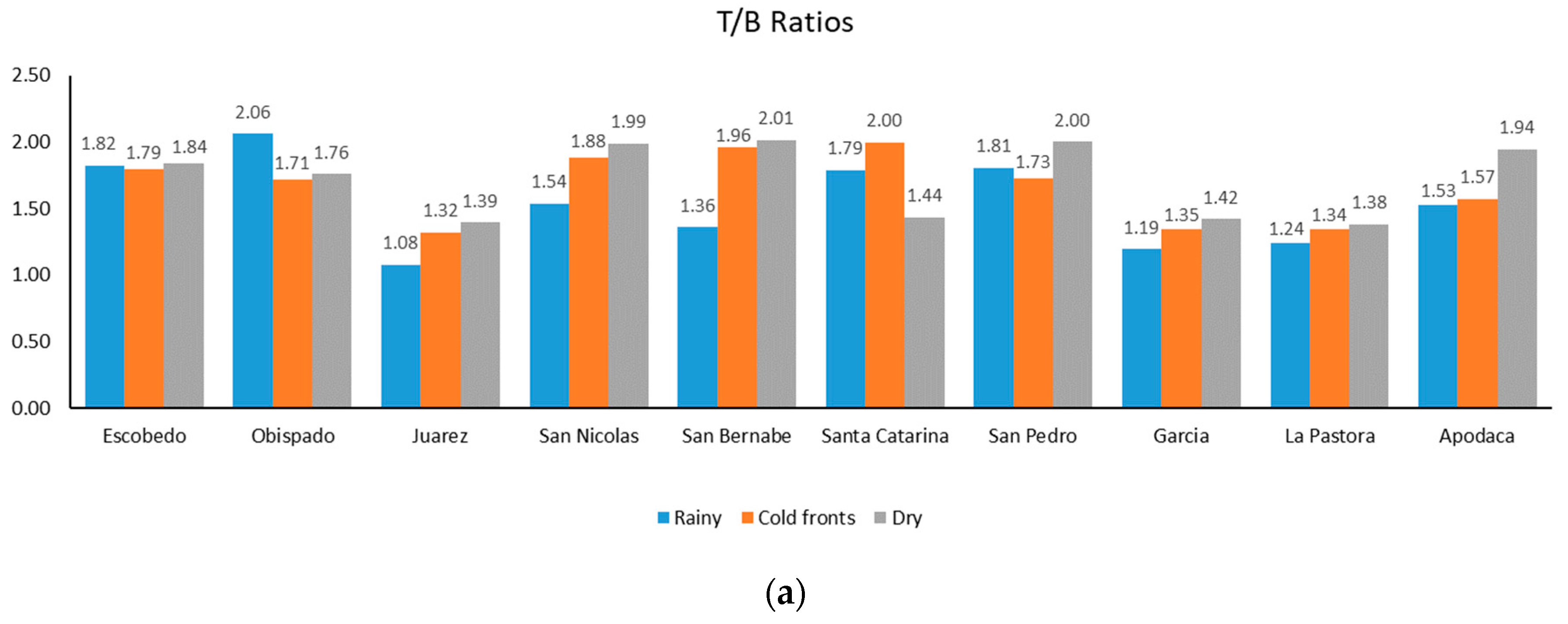

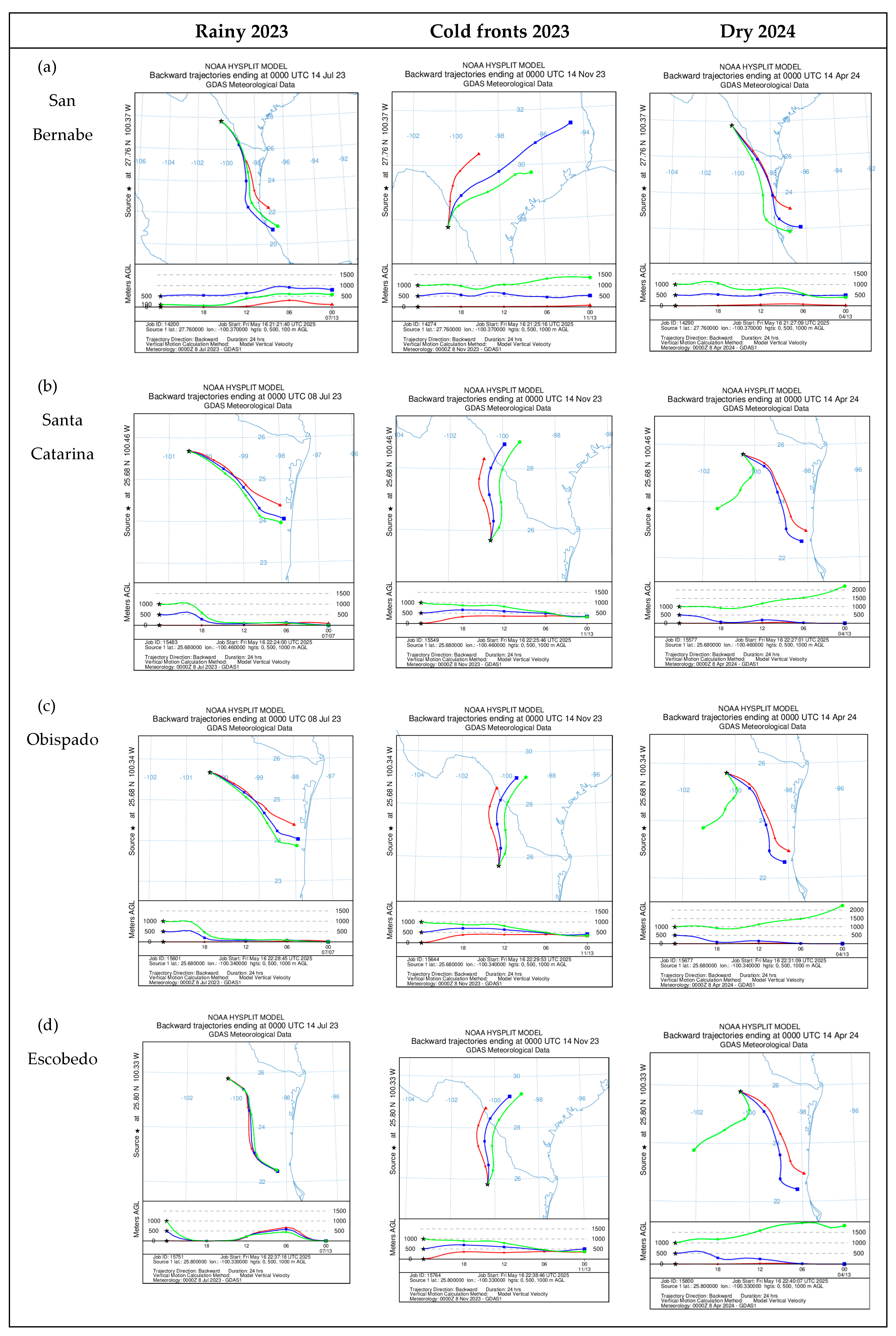
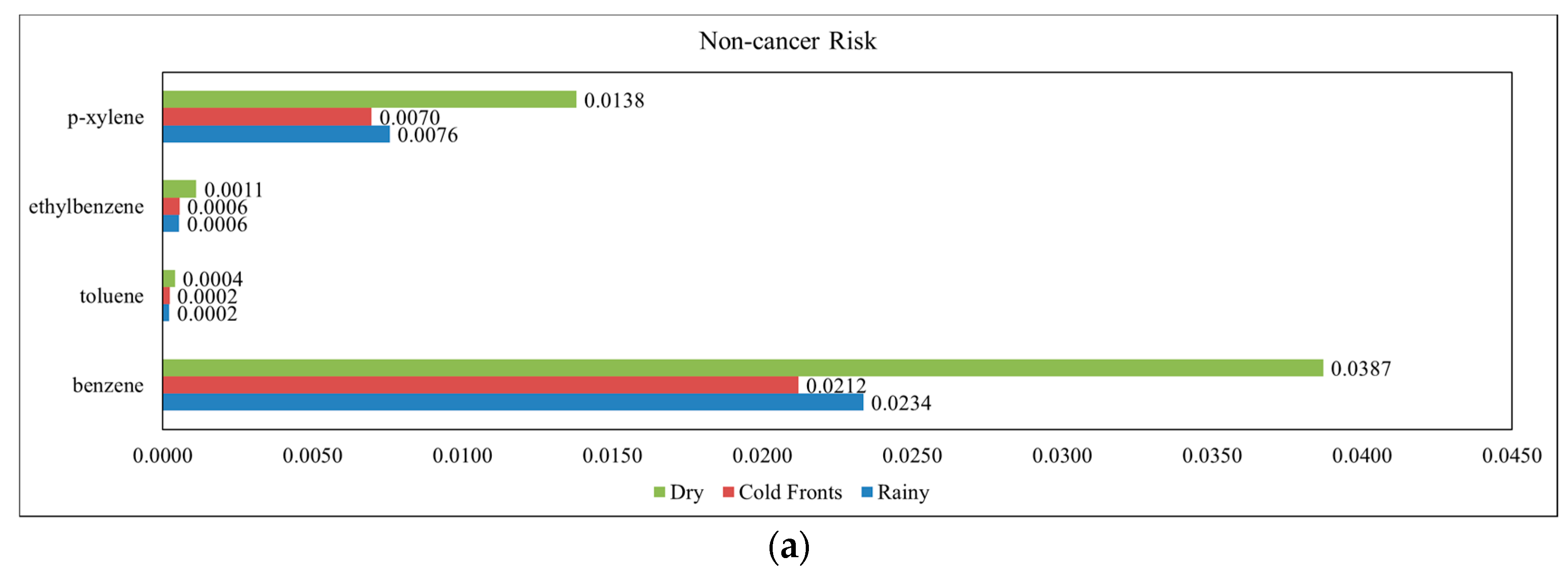
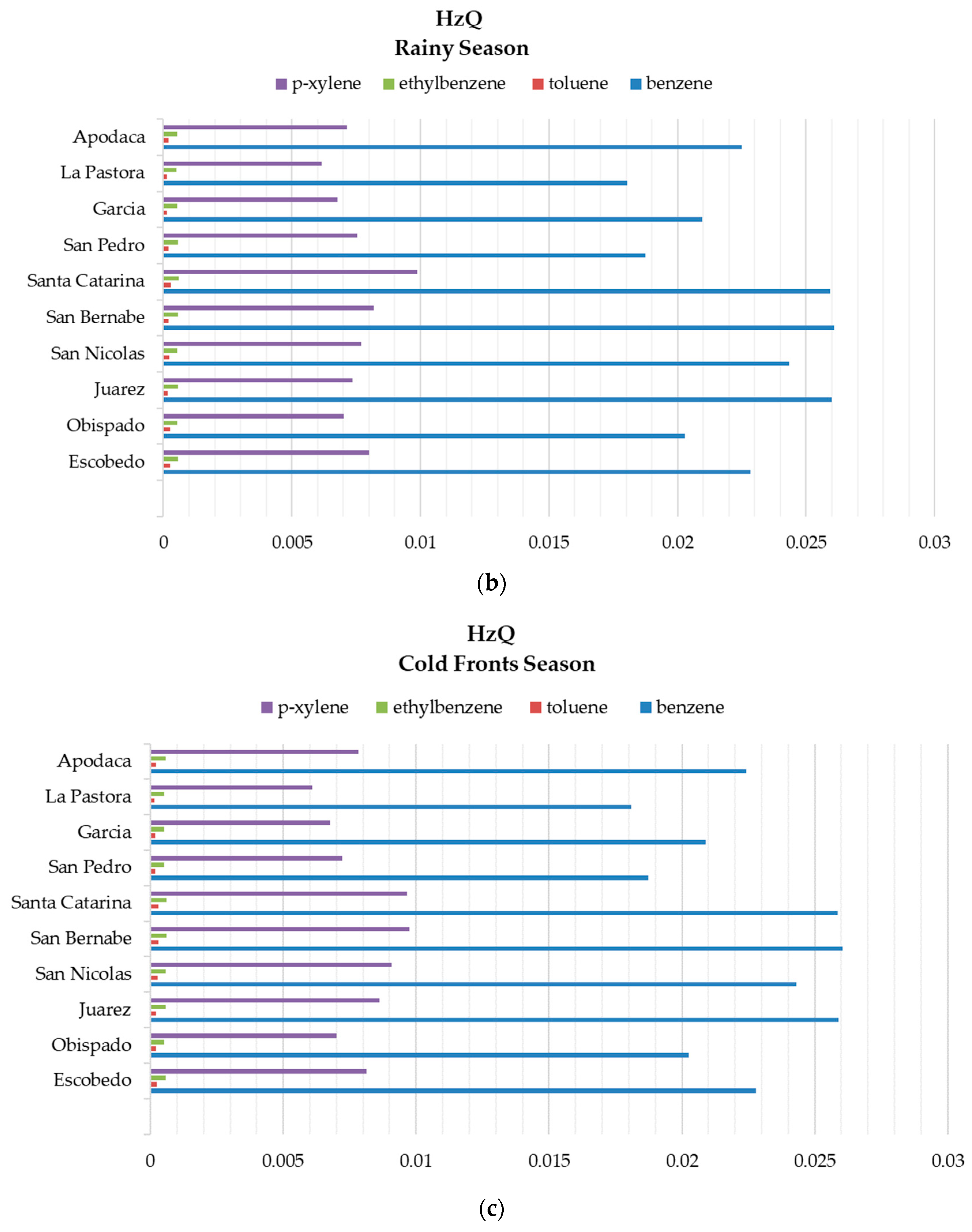
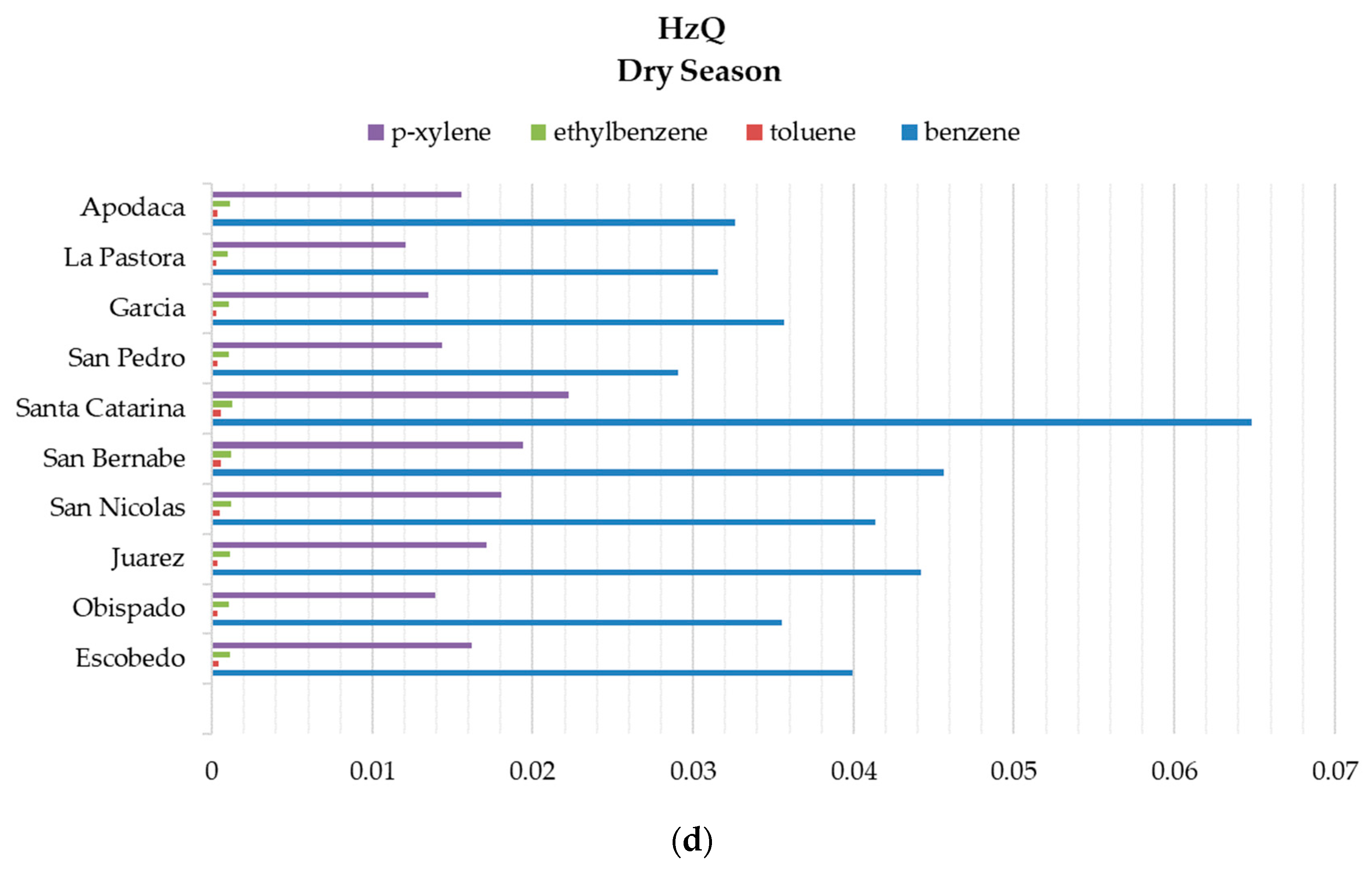
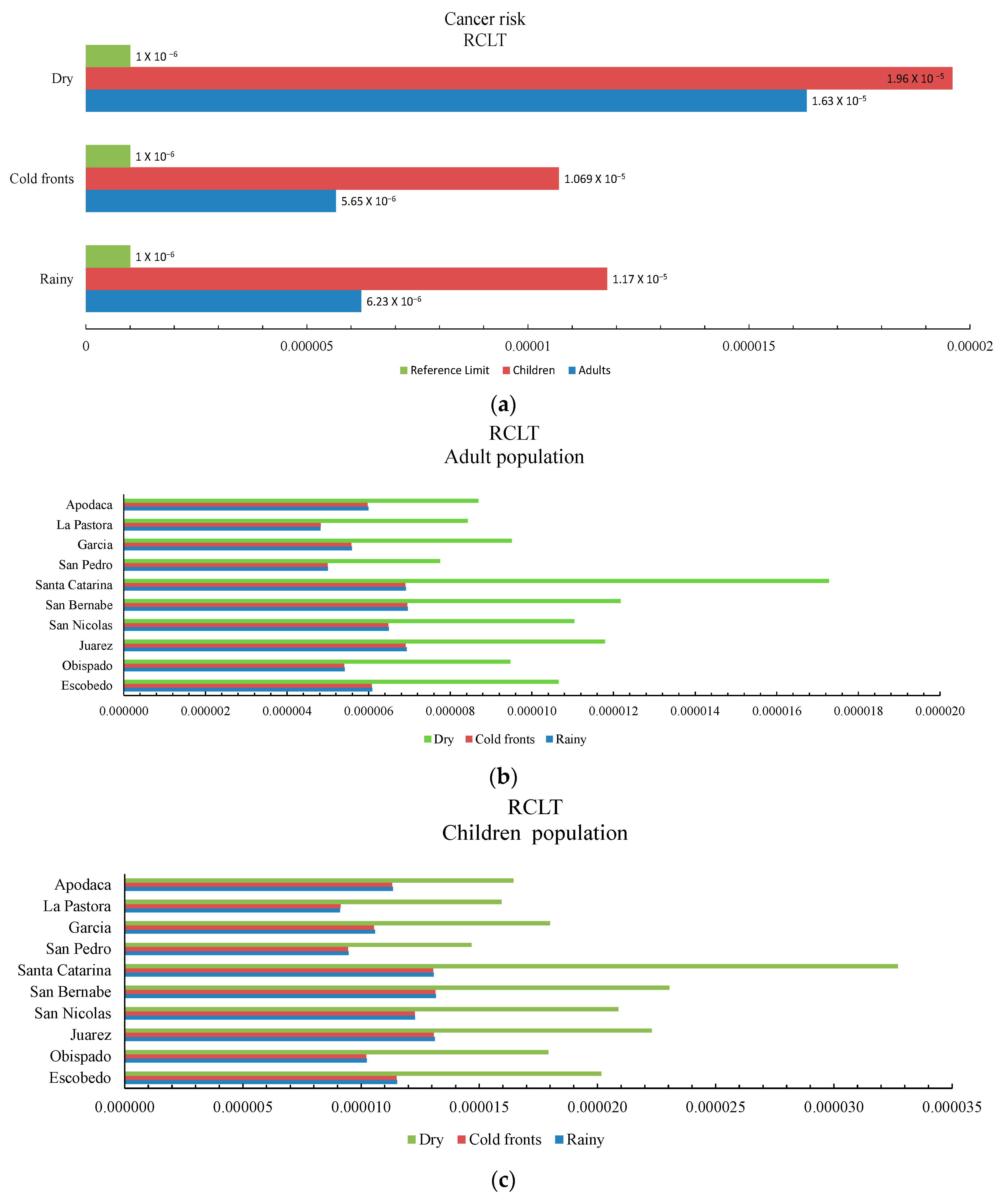
| Parameter/Compound | Benzene | Toluene | Ethylbenzene | p-Xylene |
|---|---|---|---|---|
| MDL (µg mL−1) | 0.05 | 0.06 | 0.06 | 0.05 |
| % RSD | 6.07 | 5.28 | 8.08 | 7.15 |
| Accuracy and Precision (0.05–100 µg m L−1) | ||||
| Average | 1.02 | 1.06 | 1.03 | 1.09 |
| % RSD | 2.2 | 5.1 | 4.7 | 6.3 |
| % Average error | 2.3 | 4.9 | 3.9 | 5.1 |
| Linearity (0.05–100 µg mL−1) | ||||
| R2 | 0.9996 | 0.9982 | 0.9998 | 0.9992 |
| (a) | ||||||||||
| B | T | E | X | CO | NO2 | O3 | PM10 | PM2.5 | SO2 | |
| B | 1 | |||||||||
| T | 0.64 | 1 | ||||||||
| E | 0.73 | 0.63 | 1 | |||||||
| X | 0.68 | 0.77 | 0.95 | 1 | ||||||
| CO | −0.42 | −0.21 | −0.58 | −0.61 | 1 | |||||
| NO2 | −0.33 | −0.006 | −0.10 | −0.09 | 0.32 | 1 | ||||
| O3 | −0.30 | −0.53 | 0.07 | −0.11 | −0.29 | 0.006 | 1 | |||
| PM10 | 0.23 | 0.26 | 0.13 | 0.19 | −0.14 | −0.17 | −0.09 | 1 | ||
| PM2.5 | −0.23 | 0.28 | −0.13 | −0.12 | 0.15 | −0.39 | −0.09 | 0.30 | 1 | |
| SO2 | 0.42 | 0.05 | −0.02 | 0.07 | −0.39 | −0.10 | −0.50 | −0.08 | −0.30 | 1 |
| (b) | ||||||||||
| B | T | E | X | CO | NO2 | O3 | PM10 | PM2.5 | SO2 | |
| B | 1 | |||||||||
| T | 0.80 | 1 | ||||||||
| E | 0.96 | 0.91 | 1 | |||||||
| X | 0.93 | 0.94 | 0.99 | 1 | ||||||
| CO | −0.51 | −0.40 | −0.48 | −0.45 | 1 | |||||
| NO2 | −0.27 | −0.001 | −0.06 | −0.02 | 0.39 | 1 | ||||
| O3 | −0.09 | −0.13 | −0.12 | −0.19 | 0.10 | −0.10 | 1 | |||
| PM10 | −0.09 | −0.19 | −0.23 | −0.14 | 0.10 | −0.27 | −0.68 | 1 | ||
| PM2.5 | −0.41 | −0.51 | −0.58 | −0.59 | −0.11 | −0.72 | 0.20 | 0.34 | 1 | |
| SO2 | 0.15 | −0.09 | 0.09 | −0.02 | −0.28 | −0.26 | 0.72 | −0.69 | 0.20 | 1 |
| (c) | ||||||||||
| B | T | E | X | CO | NO2 | O3 | PM10 | PM2.5 | SO2 | |
| B | 1 | |||||||||
| T | 0.75 | 1 | ||||||||
| E | 0.86 | 0.87 | 1 | |||||||
| X | 0.84 | 0.90 | 0.99 | 1 | ||||||
| CO | −0.15 | 0.04 | −0.07 | 0.04 | 1 | |||||
| NO2 | 0.006 | 0.53 | 0.47 | 0.50 | 0.26 | 1 | ||||
| O3 | 0.31 | 0.56 | 0.31 | 0.37 | 0.43 | 0.30 | 1 | |||
| PM10 | 0.08 | −0.19 | −0.07 | −0.03 | 0.06 | −0.35 | 0.06 | 1 | ||
| PM2.5 | −0.22 | −0.41 | −0.58 | −0.59 | −0.29 | −0.77 | 0.05 | 0.33 | 1 | |
| SO2 | 0.49 | 0.68 | 0.73 | 0.63 | −0.28 | −0.18 | −0.06 | −0.69 | 0.09 | 1 |
| Location | B | T | EB | X | Reference |
|---|---|---|---|---|---|
| Heavy traffic area. Jakarta, Indonesia. | 21.90 | 73.40 | 23.90 | 17.10 | [56] |
| Urban site. Skopje, Macedonia. | 0.81 | 5.88 | 1.74 | 3.37 | [15] |
| Heavy traffic area. New York, USA. | 0.82 | - | - | - | [57] |
| Parks. New York, USA. | 0.52 | - | - | - | [57] |
| International Airport. South Africa. | 17.9 | 54.2 | 16.80 | 75.01 | [58] |
| Urban site. Korea. | 24.5 | 11.10 | 0.89 | 6.60 | [59] |
| Urban site. Minnesota, USA. | 3.10 | 8.80 | - | 1.50 | [57] |
| Urban site. Minneapolis, USA. | 1.30 | 3.00 | - | 0.70 | [57] |
| Urban site. Athens, Greece. | - | 63.3 | - | 72.3 | [60] |
| Urban site. Florence, Italy. | 5.50 | - | - | - | [19] |
| Area close to a gas station. Salvador, Brazil. | 211.8 | 107.5 | 17.48 | 89.73 | [13] |
| Urban site. Algiers, Algeria. | 16.7 | 40.5 | 6.8 | 7.4 | [61] |
| Urban site. Escobedo, MAM. | 0.56 | 1.56 | 0.70 | 0.93 | This study |
| Urban site. Obispado, MAM. | 0.76 | 1.39 | 0.53 | 0.70 | This study |
| Urban site. Juarez, MAM. | 0.96 | 1.23 | 0.77 | 1.10 | This study |
| Urban site. San Nicolas, MAM. | 0.90 | 1.66 | 0.77 | 1.16 | This study |
| Industrial site. San Bernabe, MAM. | 0.98 | 1.78 | 0.80 | 1.24 | This study |
| Industrial site. Santa Catarina, MAM. | 1.16 | 1.91 | 0.83 | 1.39 | This study |
| Urban site. San Pedro, MAM. | 0.66 | 1.25 | 0.71 | 0.97 | This study |
| Rural site. Garcia, MAM. | 0.78 | 1.04 | 0.71 | 0.90 | This study |
| Rural site. La Pastora, MAM. | 0.68 | 0.90 | 0.67 | 0.81 | This study |
| Urban and Industrial site. Apodaca, MAM. | 0.78 | 1.33 | 0.74 | 1.01 | This study |
Disclaimer/Publisher’s Note: The statements, opinions and data contained in all publications are solely those of the individual author(s) and contributor(s) and not of MDPI and/or the editor(s). MDPI and/or the editor(s) disclaim responsibility for any injury to people or property resulting from any ideas, methods, instructions or products referred to in the content. |
© 2025 by the authors. Licensee MDPI, Basel, Switzerland. This article is an open access article distributed under the terms and conditions of the Creative Commons Attribution (CC BY) license (https://creativecommons.org/licenses/by/4.0/).
Share and Cite
Cerón Bretón, J.G.; Cerón Bretón, R.M.; Aguilar Ucán, C.A.; Montalvo Romero, C.; Espinosa Guzmán, A.A.; Carranco Lozada, S.E.; Ramírez Lara, E.; Espinosa Fuentes, M.d.l.L.; Uc Chi, M.P. Assessment of Aromatic Hydrocarbons in Urban Air: A Study from a Northern Mexican Megacity. Atmosphere 2025, 16, 649. https://doi.org/10.3390/atmos16060649
Cerón Bretón JG, Cerón Bretón RM, Aguilar Ucán CA, Montalvo Romero C, Espinosa Guzmán AA, Carranco Lozada SE, Ramírez Lara E, Espinosa Fuentes MdlL, Uc Chi MP. Assessment of Aromatic Hydrocarbons in Urban Air: A Study from a Northern Mexican Megacity. Atmosphere. 2025; 16(6):649. https://doi.org/10.3390/atmos16060649
Chicago/Turabian StyleCerón Bretón, Julia Griselda, Rosa María Cerón Bretón, Claudia Alejandra Aguilar Ucán, Carlos Montalvo Romero, Alberto Antonio Espinosa Guzmán, Simón Eduardo Carranco Lozada, Evangelina Ramírez Lara, María de la Luz Espinosa Fuentes, and Martha Patricia Uc Chi. 2025. "Assessment of Aromatic Hydrocarbons in Urban Air: A Study from a Northern Mexican Megacity" Atmosphere 16, no. 6: 649. https://doi.org/10.3390/atmos16060649
APA StyleCerón Bretón, J. G., Cerón Bretón, R. M., Aguilar Ucán, C. A., Montalvo Romero, C., Espinosa Guzmán, A. A., Carranco Lozada, S. E., Ramírez Lara, E., Espinosa Fuentes, M. d. l. L., & Uc Chi, M. P. (2025). Assessment of Aromatic Hydrocarbons in Urban Air: A Study from a Northern Mexican Megacity. Atmosphere, 16(6), 649. https://doi.org/10.3390/atmos16060649










